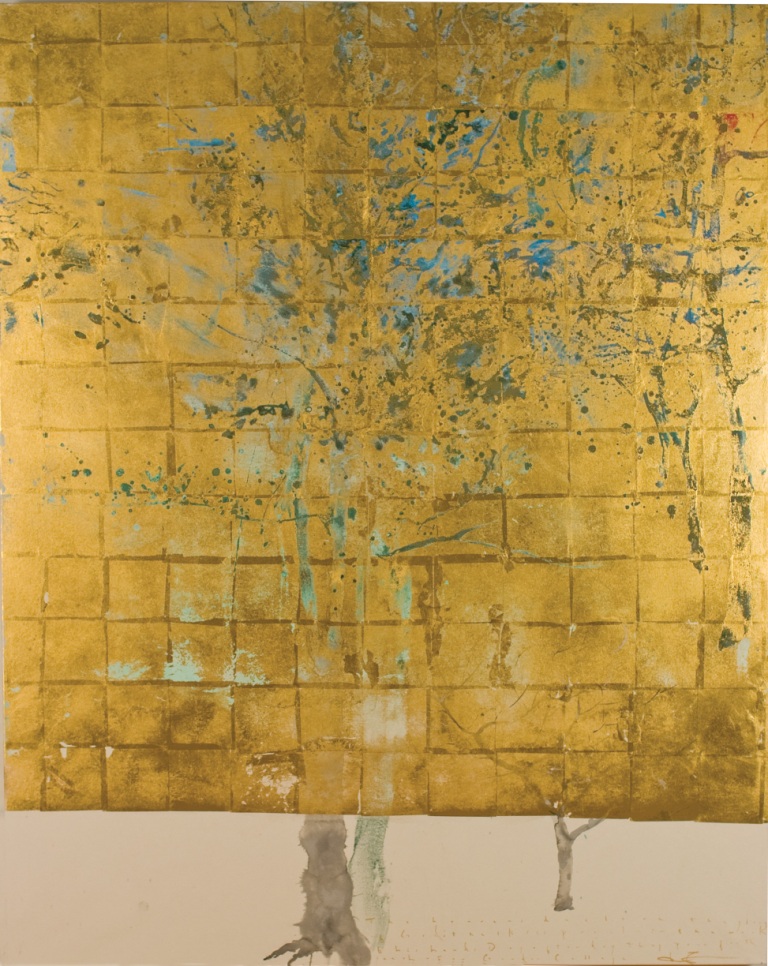Artists

Fujimura, Makoto - VM - Cisca Ireland-Verwoerd
Golden Pines-Gordon by Makoto Fujimura

Visual Poetry
by Cisca Ireland-Verwoerd
Makoto Fujimura (1960) was born in Boston to Japanese parents. He was educated in the US (Bucknell University) and Japan, where he studied traditional Japanese art. Fujimura’s work reflects two cultures, as he combines the medieval technique of Nihonga (using ground minerals and precious metals in hide glue) with abstract expressionism. Just as in Asian art, nature and human experience are often suggested with colors and vague forms rather than with explicit outline. This makes the world of Fujimura one of mystery. We can only enter this world when we take the time to stand still and look and meditate.
Fujimura’s paintings change over time. For instance, he uses silver that will tarnish and become cloudy and dark, and gold leaves that become more transparent as the minerals “settle.” Fujimura uses natural materials. He grinds up minerals and metals and combines them with a glue of animal hide. This painstaking process and the visible effects of aging tell us of Fujimura’s philosophy: art reflects the materiality of the created world, as well as the reality of suffering (crushing and aging). At the same time, his work also tells us of the transcendent splendor of God and his creation. We see the metals and minerals refracting light in ever-changing ways, and we think of the subtleties and enchantment of life. Slowly, Fujimura draws us into his deeply spiritual visual poetry and we marvel at the ethereal beauty that can be present in the midst of life’s darkness and destruction.
Golden Pines-Gordon was commissioned by Gordon College, a Christian College in Massachusetts, for their new Science Center (2008). When Fujimura visited the yet unfinished building, he was inspired by two pine trees outside in front of the Coy Pond. Today the same trees and pond are still visible through the window left of the painting. The real trees and the painting exist side by side, just as science and art exist in close relationship. Science and art both describe and explore God’s creation, only expressed in different “languages.”
The painting is fairly large (48x60 inches, 122x152 cm) and is almost entirely covered by thin squares of gold leaf. We associate gold with spirituality and eternity; it reminds us of the golden backgrounds of icons and illustrated manuscripts. Fujimura uses layers of gold and vibrant, earth-bound colors. Alternatively, they hide and reveal each other.
In the middle of the painting we see a large tree that refers to the mystery of creation. The silvery trunk with its shadow are planted in a layer of unpainted kumohada (Japanese rag paper). It stretches out its branches and clusters of pines throughout the expanse of gold. We notice some brush strokes, but much of the tree is suggested by dripped splotches of deep blue azurite and blue-green malachite. Diagonally on the right we see several trunks with leaves that suggest the receding line of trees on the other side of the college’s Coy Pond. This perspective creates a depth between the large tree in the middle and the trees on the right.
A small tree on the lower right stretches out its main bare branch toward the large tree, as in deference. This tree connotes the scientific realm, bound to the closed system of nature. If we look carefully, we see golden squiggles under the small pine, as if forming its foundation. Only when we are familiar with the text from Ps. 19:1-2 can we decipher it: “The heavens declare the glory of God; the skies proclaim the works of his hands. Day after day they pour forth speech. For Gordon College.” In Fujimura’s visual poetry science and creation express the same: we experience the glorious presence of God.
*******
More about Makoto Fujimura: For Fujimura, art is not something he “produces,” but a process that reveals the core of his humanity. This is why his activities are not limited to studio painting. Fujimura also makes video installations, writes, lectures, collaborates with musicians, mentors art students, and helps with church planting activities. Based in New York City, two blocks from “Ground Zero,” he initiated the TriBeCa Temporary project to provide a place of healing for local artists after 9/11. In 1990, Fujimura founded the non-profit organization IAM (International Arts Movement), whose mission is to “gather artists and creative catalysts to wrestle with the deep questions of art, faith and humanity in order to inspire the creative community to engage the culture that is and create the world that ought to be.” www.makotofujimura.com
Books
- Refractions: A Journey of Faith, Art, and Culture, Makoto Fujimura and Tim Keller (Colorado Springs: NavPress, 2009)
- Objects of Grace: Conversations on Creativity and Faith, James Romaine (Baltimore: Square Halo Books, 2002), p 150-173.
- English Standard Version of the Bible, to be released by Crossway in January 2011 to commemorate the four hundred year anniversary of the King James Bible, will have five works of Fujimura illustrating the four gospels.
Gallery
Fujimura’s main exhibitor is the Dillon Gallery in New York City.
Cisca Ireland-Verwoerd resides in Boston, MA, with her husband and son. She lectures and writes about her two favorite topics: mission and theology in art.
ArtWay Visual Meditation August 15, 2010


